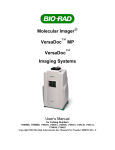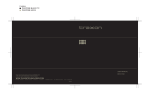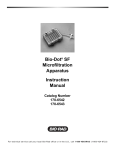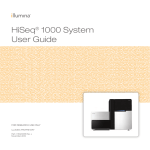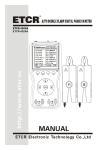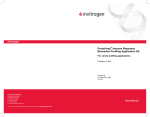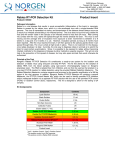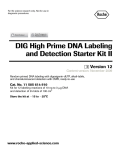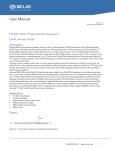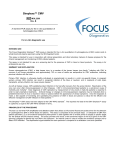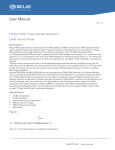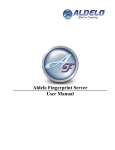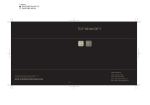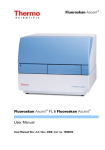Download Stripping and Preparation of CombiMatrix 4X2K Microarrays for Re
Transcript
Stripping and Preparation of CombiMatrix 4X2K Microarrays for Re-hybridization (PTL002) CustomArray™ Stripping Kit for 4X2K (Product Number # 610024) Stripping and Preparation of 4X2K Microarrays for Re-hybridization Protocol Workflow CombiMatrix Microarray after Hybridization and Imaging Store the microarray wet, do not let it dry out. Proceed to the Stripping Protocol as soon as possible after imaging. Stripping 1 hour (10-15 min hands on) Washing 30 min hands on Imaging 10 – 15 min Re-hybridization As required by the Hybridization Protocol Stripping and Preparation of 4X2K Microarrays for Re-hybridization (PTL002) - Rev 01 Page i www.combimatrix.com Stripping and Preparation of 4X2K Microarrays for Re-hybridization Table of Contents Table of Contents ........................................................................................................................................ ii Introduction ................................................................................................................................................ 1 Materials and Equipment Provided with CustomArray™ Stripping Kit................................................................. 2 Materials and Equipment Required (not provided)........................................................................................... 2 Microarray Assembly with Stripping Cap, Gasket and Clamp............................................................................. 3 Microarray Stripping ..................................................................................................................................... 5 Washing of Microarray after Stripping ............................................................................................................ 6 Imaging of Microarray after Stripping ............................................................................................................ 7 Preparation of Stripped Microarray for Re-hybridization ................................................................................... 8 Storage of Stripped Microarray...................................................................................................................... 8 Stripping and Preparation of 4X2K Microarrays for Re-hybridization (PTL002) - Rev 01 Page ii www.combimatrix.com Stripping and Preparation of 4X2K Microarrays for Re-hybridization Introduction This manual describes how to strip labeled RNA and/or DNA targets from CombiMatrix 4X2K microarrays using the CustomArray™ Stripping Kit, and how to prepare the stripped microarrays for re-hybridization with new labeled targets. The stripping procedure is based on denaturation of DNA:DNA or DNA:RNA hybrids, resulting in labeled targets being removed from the oligonucleotide probes and subsequently washed off the microarray. Stripping and re-hybridization may be repeated three times, therefore each microarray can be used up to a maximum of four times. CombiMatrix does not recommend increasing the number of re-uses. The stripping protocol is recommended for CombiMatrix microarrays that have standard oligonucleotide probe length of 40-mer or less. Probes that are longer than 40-mer may not be stripped completely. The protocol has been optimized for targets labeled with biotin, or fluorescent dyes Cy5® and AlexaFluor® 647. Use of the CustomArray™ Stripping Kit for targets labeled with other fluorescent dyes is not recommended. Specifically, Cy3® labeled probes may exhibit residual background after stripping. Effective stripping also depends on the user's selection of target labeling and preparation protocols, and microarray handling during hybridization. CombiMatrix recommends the investigators to test whether their experimental approach is suitable for microarray re-use. The following issues may result in incomplete stripping: Drying of the semiconductor surface while targets are hybridized to microarray probes will invariably preclude stripping of the microarray. Once the hybridized nucleic acids are dried, they cannot be removed. Labeling of targets with incorporation of amino allyl nucleotide derivatives. CombiMatrix recommends to instead use the labeling methods for direct dye or biotin incorporation. Nucleic acid targets of large size tend to precipitate in the porous reaction layer covering the microarrays semiconductor and will not strip easily. Low molecular weight target material must be used for stripping to be effective. To achieve optimum hybridization and stripping results, target samples need to be fragmented. The fragment size should be in the range of 50 to 200 nucleotide for RNA, and from 50 to 500 nucleotide for DNA, respectively. Microarray overloading with targets during hybridization. CombiMatrix recommends to use no more than 2 microgram for a sector of a 4X2K microarray. In some cases, saturated (i.e. overloaded) spots cannot be completely stripped, and then the concentration of target material should be reduced for efficient stripping. The described microarray overloading is not an issue for stripping of short targets such as microRNA. The four sectors of a 4X2K microarray are stripped in a single-chamber Stripping Cap provided with the CustomArray™ Stripping Kit. The quality of stripping must be determined prior to re-hybridization. This is achieved by imaging the stripped microarray with the same high-resolution fluorescent microarray scanner and the same PMT gain settings as used for the first hybridization and imaging of the microarray. The re-hybridization of the stripped microarray may be performed in the same way as the initial hybridization. For details please refer to the corresponding CombiMatrix Hybridization Protocol for 4X2K microarrays. New hybridization caps for re-uses are provided with the CustomArray™ Stripping Kit. IMPORTANT! After hybridization and imaging, CombiMatrix microarrays must be kept wet, either in a tube or slide-holder containing 1X PBS or in Imaging Solution with the LifterSlip™ attached. Do not allow the semiconductor microarray surface to dry, as this will prevent any further use. Avoid prolonged storage of hybridized arrays prior to stripping: instead, strip the microarrays first, and store them wet in Imaging Solution or 1X PBS at 4oC for a maximum of 2 weeks. Stripping and Preparation of 4X2K Microarrays for Re-hybridization (PTL002) - Rev 01 Page 1 of 8 www.combimatrix.com Materials and Equipment Provided with CustomArray™ Stripping Kit One kit is intended for 25 uses. CustomArray™ Kit for 4X2K (Product Number # 610024) Stripping Cap (multiple use) Disposable Gaskets (O-rings) for Stripping Cap Screw Plugs for Stripping Cap Stripping Solution LifterSlip™ coverslips Imaging Solution 4X2K Hybridization Caps (for Re-hybridization) Quantity 1 25 2 1 bottle of 25 ml 50 1 bottle of 10 ml 25 IMPORTANT! The CustomArray™ Stripping Solution contains ethanolamine, which is highly corrosive and can cause severe burns. The solution must be handled under a fume hood at all times. Wear protective clothing including gloves, lab coat, and goggles at all times. Follow all instructions for handing and disposal as indicated in the Material Safety Data Sheet (MSDS) provided. Materials and Equipment Required (not provided) CombiMatrix CustomArray™ Stripping Clamp for 12K (multiple use up to 100 times), Product Number 610010 NOTE 1: The CombiMatrix CustomArray™ Stripping Clamp for 12K is universal for all CombiMatrix microarrays, including the 4X2K format. The Clamp may be used up to 100 times. Some staining may occur on the surface of Clamp from spilled Stripping Solution, however, this will not affect the Clamp performance. NOTE 2: Do NOT use the CombiMatrix 4X2K hybridization clamps and caps with this kit. The Stripping Clamp is specifically designed to withstand the corrosive chemicals in the Stripping Solution, and to prevent leakage from the Stripping Cap. 65ºC Incubator Standard, high-resolution fluorescent microarray scanner (CombiMatrix recommends the Axon Instruments Genepix® 4000B and 4200A microarray scanners, and the Perkin Elmer ScanArray® microarray scanners) Nuclease-free water 95% ethanol 10X PBS buffer (1.37M Sodium Chloride, 0.027M Potassium Chloride, 0.08M Sodium Phosphate dibasic, 0.02M Sodium Phosphate monobasic, pH 7.4; Ambion Cat.# 9625) diluted to 1X PBS Labeled target (DNA or RNA) samples for re-hybridization Other materials required for microarray hybridization as listed in the CombiMatrix Hybridization Protocols for 4X2K Microarrays Micropipettors, tips, sterile plastic ware Powder-free gloves, Nitrile or Chloroprene (not Latex) Personal protection wear: lab coat and protective goggles. Stripping and Preparation of 4X2K Microarrays for Re-hybridization (PTL002) - Rev 01 Page 2 of 8 www.combimatrix.com Microarray Assembly with Stripping Cap, Gasket and Clamp IMPORTANT! The disposable gaskets (O-rings) for the Stripping Cap supplied with the kit are intended for single-use only. Re-use of gaskets may cause leakage of the Stripping Solution from the Stripping Cap. Dispose of the used gasket upon completion of this protocol. 1. The Stripping Cap and Screw Plugs supplied with the kit can be used for 25 stripping reactions. Wash the Stripping Cap and Plugs with ethanol and dry carefully with a paper towel/tissue. Place a new gasket into the O-ring groove on the Stripping Cap (see Figure 1). 2. Open the Stripping Clamp by turning the knob counter-clockwise. 3. Take a hybridized microarray that has been imaged (and you are satisfied with the image), and submerge into a tube or slide-holder containing 1X PBS until the LifterSlip™ slides off the array. IMPORTANT! After hybridization and imaging, the microarray must be kept wet, either in 1X PBS or in the Imaging Solution with the LifterSlip™ attached. If the array dries out, it cannot be re-used. 4. Remove the microarray from 1X PBS and carefully wipe the back of the slide and the area surrounding the semiconductor array with a paper towel/tissue. 5. Place the microarray into the Stripping Clamp with the array semiconductor side-up, and the microarray label close to the knob (see Figure 1). Stripping Clamp with CombiMatrix Microarray Gasket Stripping Cap Screw Plugs Figure 1. Placement of a microarray in the CustomArray™ Stripping Clamp. Stripping and Preparation of 4X2K Microarrays for Re-hybridization (PTL002) - Rev 01 Page 3 of 8 www.combimatrix.com 6. Position the Stripping Cap with the gasket-side down over the microarray, so that it covers the semiconductor array area. The arm of the Stripping Cap should fit into the stop in the stripping clamp (see Figure 2). Figure 2. Position of the Stripping Cap over the microarray in the CustomArray™ Stripping Clamp. 7. Close the CustomArray™ Stripping Clamp and turn the knob clockwise to apply pressure and secure the Stripping Cap. To fill up the stripping chamber, place the Stripping Clamp horizontally and use the solution portals as shown in Figure 3. Figure 3. Pipetting of solutions into the assembled CustomArray™ Stripping Clamp. Stripping and Preparation of 4X2K Microarrays for Re-hybridization (PTL002) - Rev 01 Page 4 of 8 www.combimatrix.com Microarray Stripping IMPORTANT! The CustomArray™ Stripping Solution contains ethanolamine, which is highly corrosive and can cause severe burns. The solution must be handled under a fume hood at all times. Wear protective clothing including gloves, lab coat, and goggles at all times. Follow all instructions for handling and disposal as indicated in the Material Safety Data Sheet (MSDS) provided. 1. Transfer the assembled CustomArray™ Stripping Clamp into a fume hood. Wear gloves, a lab coat and protective goggles. 2. Place the microarray horizontally, and add/remove solutions through the portals of the Stripping Cap using a micropipettor. 3. Rinse the Stripping Cap chamber with 500 µl the Stripping Solution by filling the chamber once and then removing the liquid. 4. Fill the Stripping Cap chamber with 500 µl of fresh Stripping Solution. Air bubbles may form at the top of the chamber, but they will not interfere with stripping (due to the large chamber volume). 5. Hold the assembly horizontally and screw the Plugs into the solution portals (see Figure 4). Avoid spilling of the Stripping Solution. If it spills, carefully wipe all liquid from the surface of the stripping clamp with a paper towel/tissue. Figure 4. Assembly of the Stripping Clamp with the screw plugs. 6. Place the assembled CustomArray™ Stripping Clamp horizontally into the 65oC incubator, and incubate for 60 minutes. IMPORTANT! The CustomArray™ Stripping Clamp assembly should not be rotated, and it should be positioned horizontally to keep the air bubble/s at the top of the chamber. Stripping and Preparation of 4X2K Microarrays for Re-hybridization (PTL002) - Rev 01 Page 5 of 8 www.combimatrix.com Washing of Microarray after Stripping IMPORTANT! The CustomArray™ Stripping Solution contains ethanolamine, which is highly corrosive and can cause severe burns. The solution must be handled under a fume hood at all times. Wear protective clothing including gloves, lab coat, and goggles at all times. Follow all instructions for handling and disposal as indicated in the Material Safety Data Sheet (MSDS) provided. 1. Remove the CustomArray™ Stripping Clamp from the incubator and place into the fume hood. 2. Let the Clamp cool down for about 5 minutes. 3. Place the assembled CustomArray™ Stripping Clamp horizontally and carefully remove the screw plugs. Aspirate the Stripping Solution by pipetting. Avoid spilling of the Stripping Solution. IMPORTANT! Do not allow the array to become dry at any step in the protocol. Proceed rapidly when changing solutions during washing steps. Do not leave the stripping chamber empty for any significant length of time. 4. 5. 6. 7. 8. 9. 10. 11. 12. Wash the chamber with 95% ethanol by filling it once and then removing the liquid. Wash the chamber with nuclease-free water by filling it once and then removing the liquid. Perform the final wash with 95% ethanol by filling the chamber once and then removing the liquid. After the final wash, immediately open the Stripping Clamp and remove the microarray. Place the microarray into a tube or slide-holder containing 1X PBS and incubate for 20 min at 65oC to rehydrate the microarray. Wash the Stripping Cap and Screw Plugs with ethanol after use. Carefully wipe the Stripping Cap and Plugs with a paper towel/tissue, and make sure that they are dry before re-use. Remove the microarray from the 1X PBS and carefully wipe the back of the slide and the area surrounding the semiconductor array with a paper towel/tissue. Cover the semiconductor array surface with Imaging Solution. IMPORTANT! Imaging Solution contains phosphate buffer, which may precipitate during shipping and handling. If precipitate is formed, heat the Imaging Solution at 60-70ºC for about 5 minutes until it dissolves. Allow the solution to cool to room temperature before applying to microarrays. Stripping and Preparation of 4X2K Microarrays for Re-hybridization (PTL002) - Rev 01 Page 6 of 8 www.combimatrix.com Imaging of Microarray after Stripping The CombiMatrix microarray must be scanned wet using the Imaging Solution supplied. The LifterSlip™ coverslip supplied with the Stripping Kit has been specifically designed to retain the Imaging Solution without contacting the array surface. IMPORTANT! Do not use a standard coverslip with the CombiMatrix microarray, as this will damage the semiconductor surface. Figure 5. CombiMatrix microarray with LifterSlip™ coverslip. 1. Make sure that the semiconductor array surface is covered with the Imaging Solution. 2. Using thin-tipped forceps, pick up a fresh LifterSlip™ and hold it so that the raised edges face the microarray. The raised edges can be detected by gently rubbing an edge with the tip of the forceps – the raised edge will feel rougher than the glass surface. 3. Lay the LifterSlip™ at an angle onto the microarray so that it is centered over the semiconductor area (see Figure 5). First touch the Imaging Solution with one side of the LifterSlip™, then slowly lower the slip down, taking care not to introduce air bubbles. If bubbles still form, lift one side of the LifterSlip™ with forceps (or a razor blade) to let the bubbles out, and lower it down again. 4. Carefully remove any excess Imaging Solution from the edge of the LifterSlip™ using a lint-free tissue, until it is resting evenly over the array. 5. Load the microarray into the scanner, taking care not to disturb the LifterSlip™ coverslip. 6. When scanning the stripped microarray, use the SAME scanner PMT gain setting as was used for the original hybridization and imaging. Do not increase the PMT gain setting, as this may increase the background fluorescence. 7. After you complete the scan, you can examine the resultant image by eye and/or perform data extraction. If using the CombiMatrix Microarray Imager software, please refer to the Quick Start Guide or the Microarray Imager User's Manual from our web site (https://webapps.combimatrix.com). 8. The stripping reaction has been successful if there are no spots visible on the array. You may still see some elements of the semiconductor array, such as the grid and contact pads along the side. NOTE: If you still observe some hybridization signals remaining on the microarray after stripping, the whole stripping protocol can be repeated. 9. After imaging is completed, proceed immediately to Preparation of Stripped Microarray for Rehybridization. Alternatively, the stripped microarray can be stored for 2 weeks using the storage procedure described below. Stripping and Preparation of 4X2K Microarrays for Re-hybridization (PTL002) - Rev 01 Page 7 of 8 www.combimatrix.com Preparation of Stripped Microarray for Re-hybridization NOTE: The Stripping Kit contains new 4X2K sectored hybridization caps for re-use of the stripped microarrays. Discard the used hybridization caps upon completion of the hybridization protocol. 1. After imaging place the stripped microarray in a tube or a slide holder containing 1X PBS to remove the LifterSlip™ coverslip. 2. Remove the microarray from the 1X PBS and carefully wipe the back of the slide and the area surrounding the semiconductor array with a paper towel/tissue. 3. Immediately assemble the stripped microarray with the new Hybridization Cap in the 4X2K Hybridization Clamp. Do NOT leave the hybridization chambers empty for any significant length of time, immediately fill them with nuclease-free water for pre-hybridization. Follow the corresponding CombiMatrix Hybridization Protocol for 4X2K microarrays. You may change the hybridization conditions if you wish, but you must perform the pre-hybridization steps as described in the protocol. Storage of Stripped Microarray NOTE: Avoid long-term storage of stripped CombiMatrix microarrays. Always keep microarrays wet during storage. 1. After imaging keep the LifterSlip™ coverslip on the array surface. Add extra imaging solution to prevent the microarray from drying. 2. Cover the microarray and LifterSlip™ with plastic wrap to prevent evaporation. 3. Store at 4oC to prevent bacterial growth. Stripped microarrays can be stored for a maximum of 2 weeks in this manner. 4. Alternatively, the stripped microarray can be stored without a LifterSlip™ in a tube or slide holder containing 1X PBS at 4oC for a maximum of 2 weeks. Stripping and Preparation of 4X2K Microarrays for Re-hybridization (PTL002) - Rev 01 Page 8 of 8 www.combimatrix.com















